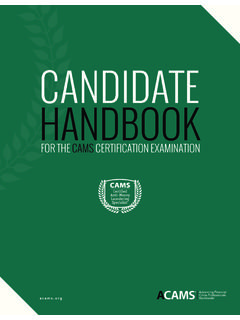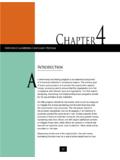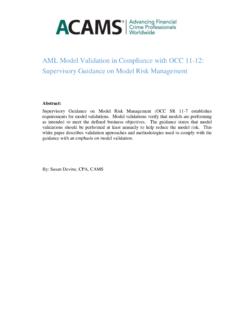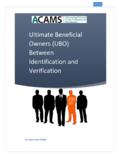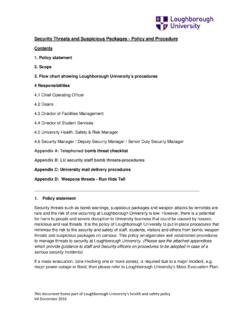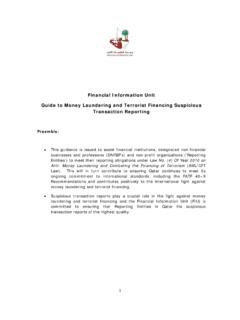Transcription of Keeping an Eye on Suspicious Activity - ACAMS
1 Keeping an Eye on Suspicious ActivityRamona Murton 2015 ACAMS FCI The Importance of Maintaining Human Analytics Keeping an Eye on Suspicious Activity 1 Table of Contents EXECUTIVE SUMMARY .. 2 CONCERNS WITH AUTOMATION WITHIN THE AML PROGRAM .. 3 Budgets Constraints .. 3 The Need to be More Cost Effective .. 3 Potential Issues .. 4 What does the future have to hold? .. 4 A Sense of Assuredness and Reliance on the Vendor.. 4 Automated Systems and the Typologies of Money Laundering .. 6 Risks .. 6 Regulatory .. 6 Legal .. 8 Operational .. 9 Reputational .. 9 BENEFITS OF MAINTAINING HUMAN ANALYTICS .. 10 Organizational .. 10 Human Eye vs Automation .. 10 Training and Development .. 11 AML 12 Regulatory.
2 12 13 Industry .. 13 Career Path .. 13 Law 14 Relationship Building .. 14 15 REFERENCES .. 16 Keeping an Eye on Suspicious Activity Page 2 Keeping an Eye on Suspicious Activity T H E I M P O R T A N C E O F M AI N TA I N I N G H U M A N A N A LY T I C S Executive Summary An increased emphasis by regulators across the globe to enforce high standards, not only in the world of financial institutions (FIs), but also in a wide range of industries, has impacted anti-money laundering (AML) and counter-terrorist financing (CTF) compliance programs. The Financial Action Task Force (FATF),1 the Egmont Group2 and the Wolfsberg Group3 work to continuously improve applicable regulations.
3 This topic is one of top priority as demonstrated by national regulatory audits and the subsequent increase in both the amount and frequency of fines. The media has captured the growing presence of industry noncompliance, as exhibited by the billions of dollars in fines imposed yearly. As these international regulatory expectations continue to mature, FIs are tasked with determining an appropriate investment in transaction monitoring. In essence, this balancing act distills to determining a right-sized approach to human analytics supplemented by automated transaction monitoring. Regardless of how FIs choose to proportion automated monitoring, the human component must remain prominent. The importance of maintaining human analytics to identify unusual or Suspicious Activity has a far-reaching impact.
4 This includes the pressure to be cost effective and to adopt automated monitoring systems while being cognizant of the impact it has on employee morale as well as profits. Other areas that influence this balancing act include the inherent problems that come with automated monitoring, the limitations of third-party solutions, unstable industry confidence and the dominant concern that automated solutions are not sophisticated enough to detect advanced AML typologies. Automated monitoring has risks: regulatory, reputation, legal and operational, which are significant concerns. These countered by the benefits of quality reports, recognition from law enforcement, team morale, and most important, regulatory compliance for reporting Suspicious or unusual transaction.
5 Although quite useful, the automated system cannot capture the abilities of the human investigator as they play a key role in the fight against money laundering and terrorist financing. Data and alerts are often only as useful as the investigator/analyst that pulls the Suspicious Activity together. Regulators as well as law enforcement are counting on the quality and quantity of these reports. Computerized systems for detection of money laundering and terrorist financing are useful alongside the knowledge and experience of the AML analyst. The key is to ensure FIs, as well as other organizations, have an AML program that recognizes the important role the human analyst plays. 1 2 3 Keeping an Eye on Suspicious Activity 3 CONCERNS WITH AUTOMATION WITHIN THE AML PROGRAM Budgets Constr a ints The Need to be More Cost Effective The growing need to be cost effective has increased the burden on cost centers to become more efficient, innovative, or automated, including AML compliance.
6 Automated transaction monitoring is an industry necessity due to the volumes and international reach of FIs. FIs simply cannot entirely rely upon manual reviews to effectively implement and manage their risk-based AML program. That said, the need to look to automation has increased with the hopes that a transaction monitoring system will provide reassurance to the organization. This includes such confidence that regulatory requirements would be more easily met, compliance less stressful and that Suspicious Activity would be captured for the most part through fine-tuned alerts. Shrinking budgets have impacted almost every department in organizations and the non-revenue generating areas are often the first to see efficiency projects underway to identify where cuts can be made.
7 If an automated system can replace a number of individuals, then the benefit of the initial cost of that system outweighs the long-term cost of an individual, which all companies know includes benefits, vacation, pension, sick days and potential salary increases. Industries have made cut backs to the human component of the business only to experience both the short-term and long-term negative impact with remaining team members. Layoffs can be perceived as a violation of the psychological contract between an organization and its employees, resulting in decreased trust and greater stress in the negative effects on the survivors of a layoff decreased commitment and productivity are more costly for high-involvement workplaces, as these workplaces rely expressly on employee involvement and motivation.
8 Not only are top-performing employees more likely to leave, but the employees that remain may exhibit less effort and involvement. Christopher Zatzick and Roderick Iverson of Simon Fraser University The impact of downsizing not only affects employees, but also impacts the bottom line. When there is a decrease in staffing in compliance, there is a potential increased risk of regulatory fines, which negatively impacts profit and loss as well as potential stock price. Companies that do not downsize perform significantly better than those who chose a hefty number of layoffs. As illustrated in the following chart Businesses that laid off 3 [percent] or less of their workforces did just as well as companies with no layoffs at all: Both groups posted 9 [percent] share price increases, on average.
9 By contrast, share prices remained flat in companies that let go 3 [percent] to 10 [percent] of their plunged 38 [percent] among fired more than 10 [percent] of their workforce. Harvard Business Review Keeping an Eye on Suspicious Activity Page 4 Debunking layoff myths by Darrell Rigby, Bain & Company, 2002 Poten tial Issu es What does the future have to hold? Many industries utilize innovation and technically savvy options to increase identifying, reporting and mitigating criminality including AML, CTF, and complying with regulatory requirements. Automation has replaced numerous jobs in history and will continue to do so, understandably in certain sectors, but not the industries counting on human analytics to identify Suspicious or unusual transactions.
10 The human knowledge and experience of a tenured employee cannot be replicated by an automated system. We have to figure out how to best balance the responsibilities between the human expert or professional and computer. I think we're going down the wrong path right now. We're too quick to hand over too much responsibility to the computer and what that ends up doing is leaving the expert or professional in a kind of a passive At the practical level, we can be smarter and wiser about how we go about automating and make sure that we keep the human engaged. The Glass Cage, Nicholas Carr A Sense of Assuredness and Reliance on the Vendor Third-party transaction monitoring technology vendors commit to offering products capable of monitoring customers transactional behavior automatically, by utilizing pertinent parameters or rules that analyze the basic customer transactions and then generate automated alerts on Activity that may be unusual and indicative of Suspicious Activity .



